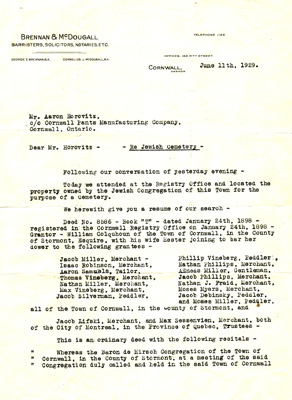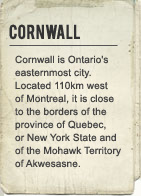Cemeteries
The first collective act of Cornwall's Jews was their decision, taken in 1897, to establish a cemetery. The Baron De Hirsch Congregation of Cornwall, as the community first called itself, signed the deed of purchase, at a cost of $117, on January 24, 1898. The signatories were: Jacob Dubinsky, Nathan J. Fraid, Aenaes Miller, Jacob Miller, Moses Miller, Nathan Miller, Moses Myers, Jacob J. Phillips, Nathan Phillips, Aaron Samuels, Jacob Silverman, Philip Vineberg, Thomas Vineberg, Max Vineberg, Isaac Robinson, Jacob Lifsky and Max Sessenvien of Montreal.
This early cemetery served the community unitl the mid-1950s, when one of the most important events in Cornwall's history occurred with the construction of the St. Lawrence Seaway. The goal of the Seaway was to allow ocean-going vessels to travel from the Atlantic Ocean to the Great Lakes, as far as Lake Superior. Excitement at the prospect of this great new project was high in Cornwall, but as it turned out, it involved unexpected costs. Contrary to both plans and promises, twelve villages, known later as the "lost villages", were flooded. In addition, Seaway construction flooded part of the original cemetery established by the Jewish community. As a result, remains from the old cemetery had to be moved under rabbinic supervision.
A new cemetery was established twenty kilometres west of Cornwall on Route 2 and a new constitution, dated August 1, 1952, was prepared in the name of the Beth El Congregation Cemetery. On the occasion of dedicating the new cemetery, Rabbi Lewin urged the community to remember that sadness and joy mingle in Jewish life, saying "We must keep our Jewish sense of duty and remind ourselves that every source of sadness may likewise be a source of joy." He added a prayer that the new cemetery would not need to be used too soon: "May the Lord G-d save us all for many years to come, may this cemetery which is dedicated today remain vacant for many years in future."









